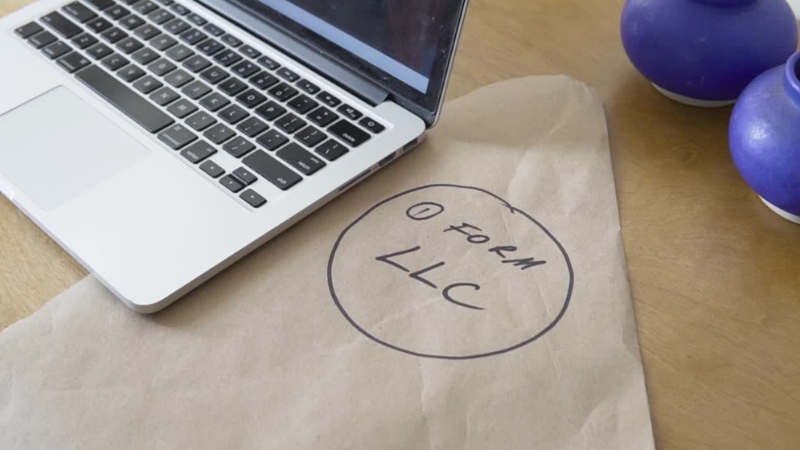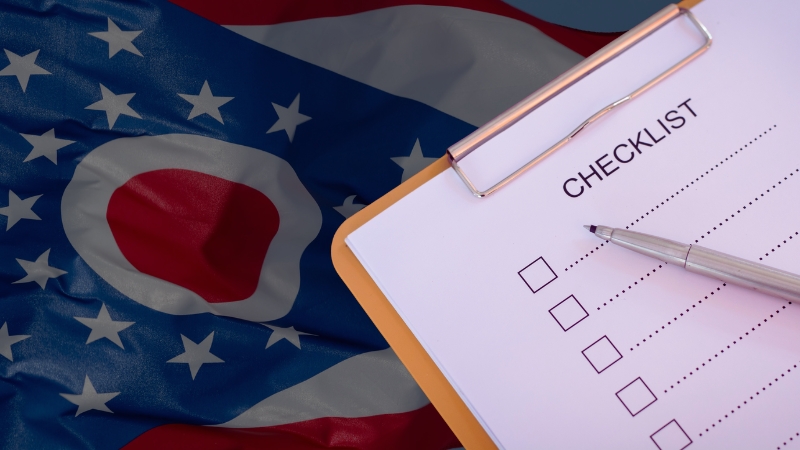Starting a business is exciting, but it can also feel like you’re carrying an armful of paperwork without a clear map. Ohio has tried to make that path smoother with online portals, centralized filing options, and a fairly straightforward sequence of steps.
If you work through the requirements in the right order, you can go from idea to operating without stumbling over missing registrations or late filings.
This guide breaks down the essential licenses, tax accounts, and legal obligations in Ohio, with practical context you won’t always find on the state’s landing pages. Think of it as a hands-on checklist you can follow from day one.
Quick-Look Startup Sequence
| Step | What You Do | Where You Do It | Why It Matters |
| 1 | Pick an entity and secure your name | Ohio Secretary of State | You need a legal shell and a name that is available |
| 2 | Appoint a statutory agent | With your formation filing | Required to accept legal service of process |
| 3 | Get an EIN | IRS | Needed for banking, payroll, and state accounts |
| 4 | Open Ohio tax accounts | Ohio Business Gateway & Department of Taxation | Covers sales tax, employer withholding, CAT, municipal filings |
| 5 | Register for unemployment insurance | Ohio Department of Job and Family Services | Establishes your SUI account and rate |
| 6 | Obtain workers’ comp coverage | Ohio Bureau of Workers’ Compensation | State fund coverage is mandatory for one or more employees |
| 7 | Get the vendor’s license or the seller’s use tax license | County Auditor or Ohio DTax | Needed if you sell taxable goods or services |
| 8 | Handle zoning, occupancy, and site permits | City or county building/zoning | Ensures your space is legal to use |
| 9 | Report new hires and set up payroll | Ohio New Hire Reporting Center & DTax | Mandatory reporting and withholding |
| 10 | Keep up with HR and filing deadlines | Commerce, BWC, ODJFS, Taxation | Ongoing compliance |
Step 1: Choose an Entity and Secure Your Business Name

The legal foundation of your company starts with the Secretary of State. Most Ohio entrepreneurs choose an LLC for flexibility or a corporation for more formal structure.
- Filing: Use Ohio Business Central to file online. You can preview fees and forms before you start.
- Name checks: Search for availability. If your brand differs from your entity name, register a trade name or report a fictitious name.
- Statutory agent: Every Ohio entity must list a statutory agent with a physical address in the state. This is the person or service that can receive lawsuits and state notices.
Step 2: Get Your Federal EIN and Choose Tax Classification
Your Employer Identification Number (EIN) is essentially your business’s Social Security number.
- Application: File for free on the IRS site. Approval is immediate.
- Tax posture: By default, an LLC is taxed as a pass-through. Some owners elect S corporation status for potential savings on self-employment tax. The election requires IRS Form 2553 and comes with deadlines tied to payroll planning.
Step 3: Open Your Ohio Tax Accounts
The Ohio Business Gateway is your starting point for most registrations. Here’s what to check:
Sales and Use Tax
- Fixed-location sellers: Apply for a regular vendor’s license through your county auditor. As of 2025, the fee is $50 (raised under House Bill 366).
- Transient vendors: If you sell across Ohio without a fixed site, register with the Department of Taxation. One transient license covers the whole state.
- Remote sellers: Out-of-state businesses crossing $100,000 in Ohio sales or 200 transactions in a year must register for a seller’s use tax license.
All sales and use tax returns are filed electronically.
Employer Withholding
Employers must withhold Ohio income tax on wages for residents and nonresidents working in Ohio. Employees complete Form IT 4. Setup is through the Gateway.
School District Withholding
Ohio has more than 200 school districts with their own income tax. Employers may need to withhold this tax as well. Use the Department’s Finder tool to confirm which districts apply.
Commercial Activity Tax (CAT)
Ohio’s CAT applies to businesses with gross receipts over a set threshold. Recent increases have exempted many smaller firms, but check the CAT guidelines each year.
Municipal Net Profits Tax
If you do business in multiple Ohio municipalities, you can elect centralized filing with the Department of Taxation instead of sending separate returns to each city. The election must be made near the start of your tax year.
Step 4: Register for Unemployment Insurance

Employers must set up a state unemployment insurance (SUI) account with the Ohio Department of Job and Family Services (ODJFS).
- Rates: New employers typically start at 2.7% on the first $9,000 of wages per employee. Construction firms use different rates.
- Reporting: Quarterly wage reports are filed online through ODJFS.
Ohio also permits certain related companies to use a “common paymaster” for consolidated payroll reporting, which can save time if you run multiple entities.
Step 5: Secure Workers’ Compensation Coverage
Ohio is one of a few “monopolistic” states where you must purchase workers’ comp insurance from the state fund.
- Application: Register with the Bureau of Workers’ Compensation.
- True-up deadline: Each year, private employers must reconcile actual payroll by August 31. Missing this deadline can mean penalties and loss of premium discounts.
Coverage is mandatory once you hire even one employee.
Step 6: Handle Zoning, Occupancy, and Site Compliance
Don’t sign a lease before confirming zoning. Cities and counties set rules on what activities are permitted in specific districts.
- Building and zoning offices: Contact them to confirm your use is allowed and whether building permits are required.
- Certificate of occupancy: Often required when moving into a new or renovated space. Issued by local building departments or the Ohio Department of Commerce.
- Industry permits: Food service, childcare, healthcare, and industrial businesses often need separate health or environmental approvals.
Step 7: Professional and Industry Licensing
View this post on Instagram
Many professions are regulated by boards that use eLicense Ohio. Examples: nursing, engineering, and real estate.
Additional permits include:
- Food service licenses from local health departments
- Liquor permits from the Division of Liquor Control
- Environmental permits from the Ohio EPA for operations with emissions or discharges
Always check the Ohio.gov licenses hub for your industry.
Step 8: Payroll, New Hire Reporting, and Posters
Once you hire staff, the compliance list grows quickly.
- New hire reporting: Employers must report all hires and rehires within 20 days through the Ohio New Hire Reporting Center.
- Minimum wage: As of January 2025, minimum wage is $10.70 per hour for non-tipped employees and $5.35 for tipped workers. Smaller employers may use the federal minimum.
- Posters: Ohio publishes required labor law posters annually. Display them where employees can see them.
- Municipal withholding: If employees split work between locations, you may need to prorate municipal tax withholding based on days worked in each jurisdiction.
Step 9: Sales Tax in Practice

Many new businesses underestimate the effort required for proper sales tax handling.
- Vendor’s license choice matters: Fixed-site vendors use county auditors, transient vendors use the Department. Remote sellers register differently.
- Electronic filing only: Ohio requires sales and use returns to be filed and paid online.
Step 10: Decide on Municipal Net Profits Centralized Filing
Ohio’s centralized system can save significant time for businesses with multiple municipal filings. Instead of preparing separate returns for each city, you can file one with the Department of Taxation.
- Election timing: Must be made near the start of your tax year.
- Court-tested: The Ohio Supreme Court has upheld the state’s right to offer centralized filing.
Step 11: Banking, Insurance, and Contracts
Beyond regulatory filings, there are practical steps every business should take:
- Operating agreement or bylaws: Even single-member LLCs should draft one. Banks often request it.
- Business bank account: Keep personal and business finances separate.
- Insurance: Workers’ comp is required, but general liability, property, and cyber insurance are wise.
- Contracts: Use clear terms for clients and vendors. Don’t rely solely on handshake agreements.
Step 12: Corporate Transparency Act Update
Complying with the Corporate Transparency Act is simple.
You’ll only need to file your company’s beneficial ownership information with FinCEN once, unless you need to update or correct information. https://t.co/dt4PaLSm33 pic.twitter.com/9OxPUDjrMD
— Financial Crimes Enforcement Network (FinCEN) (@FinCENnews) February 23, 2024
The federal Corporate Transparency Act introduced Beneficial Ownership Information (BOI) reports with FinCEN in 2024.
In 2025, FinCEN shifted the rules again, removing immediate BOI reporting for new companies and extending deadlines to March 21, 2025. Always check FinCEN’s BOI page for the latest requirements, since rules have been changing.
Step 13: Ohio Small Business by the Numbers
According to the SBA Office of Advocacy 2025 profile, Ohio small businesses employed about 2.2 million people in 2022 – roughly 43.8% of the state’s total workforce.
The numbers show how critical small enterprises are to the state’s economy, from local restaurants to manufacturing startups.
Step 14: Your First 30 Days Checklist
- File your entity and appoint a statutory agent
- Get your EIN and open a bank account
- Register with the Gateway for all required taxes
- Register with ODJFS for unemployment insurance
- Apply for workers’ comp coverage
- Decide on centralized municipal filing
- Secure zoning and occupancy approvals
- Obtain the vendor’s or seller’s use license if needed
- Post required labor notices and set payroll to state minimum wage rules
- Report all new hires within 20 days
Step 15: Common Pitfalls in Ohio
- Forgetting to apply for workers’ comp coverage early enough
- Using the wrong type of vendor’s license
- Missing municipal tax filings for employees working across city lines
- Signing a lease before confirming zoning
- Assuming the CAT tax does or does not apply without checking annual thresholds
Step 16: Where to Get Help
- Business formation: Ohio Secretary of State Business Services
- Taxes: Ohio Business Gateway
- Unemployment: ODJFS Employer Services
- Workers’ comp: Ohio BWC Employer Services
- Licenses: Ohio.gov License and Permits
- Local zoning: Check city or county building departments (e.g., Columbus publishes forms and fee schedules online)
Final Words
@corporatedirectThe correct Ohio LLC Creation Process Here’s how to open an LLC in Ohio! #OhioLLC #OpenLLCinOhio #LLCinOhiohowtostart #CreateLLCinOhio #StartingabusinessinOhio Follow Corporate Direct on Instagram: https://loom.ly/mWWjBNY 📞 Want personal help? Schedule a FREE 15-minute consult with our team here: https://loom.ly/ofxgUZo 👥 At CD, you talk to a real person who understands how to actually protect your wealth — no fluff, no sales gimmicks. DISCLAIMER: The contents of this video are NOT LEGAL ADVICE and do not apply to your specific circumstances. This information is provided for general informational and educational purposes only. Viewing this video DOES NOT CREATE AN ATTORNEY-CLIENT RELATIONSHIP. We highly encourage you to seek professional legal advice before acting or relying on any information contained in this video.♬ original sound – Corporate Direct
Launching a company in Ohio is less about guessing and more about lining up filings in the right sequence.
Start with formation and your statutory agent, grab your EIN, set up state tax accounts, and secure workers’ comp coverage before you hire. From there, it’s about zoning, licensing, and keeping a steady filing calendar.
If you keep documents in one place, rely on the Ohio Business Gateway whenever possible, and double-check thresholds each year, you’ll save yourself from the headaches that trip up many first-time business owners.
Ohio has more than 2 million small businesses already making it work – you’ll be in good company.

